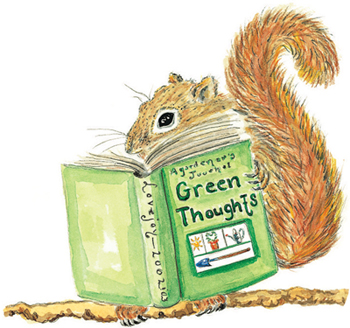
“The first rule is to keep an untroubled spirit. The second is to look things in the face and know them for what they are.”
—Marcus Aurelius
The old adage, “Know thine enemies,” is especially important in the garden. By understanding pests, knowing when they arrive or hatch (see Calendar) where they like to hide, or what plants most attract them, a gardener can remain at least a few strides ahead of them. Often, just a dusting of baby powder, a sleeve of tinfoil, or a mulch of fresh hair clippings is enough to deter foes and save your harvest.

Save small tin or aluminum cans to use as long-lasting cutworm collars. Remove the top and bottom lids and labels, wash the can, and sink it at least 1 inch into the soil. Plant seeds or place seedlings in the center of the can. Keep the inside of the collar free of debris. Sprinkle a ring of cornmeal around the outside of the collar. This is the last supper for cutworms (they feed on it but they can’t digest it).
Nematodes and cutworms work their underground havoc just a few inches below the surface and are stumped when they run into a wall of plastic. Clean and disinfect old 1- and 5-gallon plastic nursery pots and cut out the bottoms. Sink the pots into the ground, leaving 2 to 3 inches above the soil line. Plant inside them.
Stop chipmunks from destroying or stealing your sunflowers and tiny tomatoes by spraying these crops with Coast of Maine Fermented Salmon (see Resources).
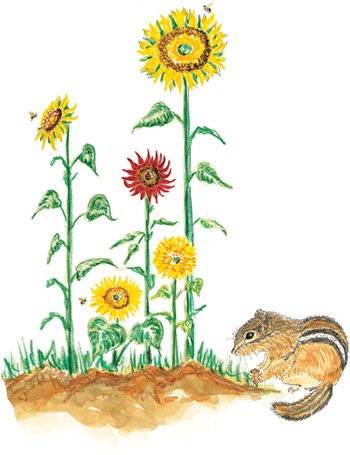
Spread a thick, broad layer of petroleum jelly or mentholated rub around tree trunks or stems of plants being “farmed” by ants.
Protect carrot crops from rust flies and other infestations by hilling the soil around them, as with potatoes, or sprinkling wood ashes or coffee grounds onto the soil when you plant the seeds. Some gardeners have success against rabbits with the old-time practice of poking matchsticks into the soil near each carrot.

Drape and twist narrow strips of silvery, lightweight Mylar through the branches of fruit trees and tie long streamers of it to the branches. The flashing light, which resembles fire, frightens and confuses birds.
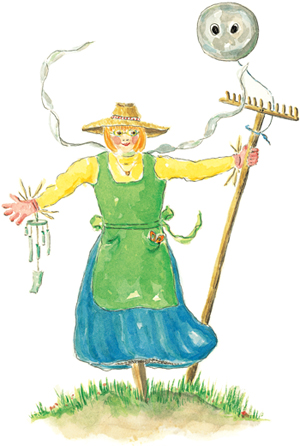
Use a scarecrow, and include something—wind chimes, prisms, and kitchen utensils—that makes noise or flashes or moves in the wind.
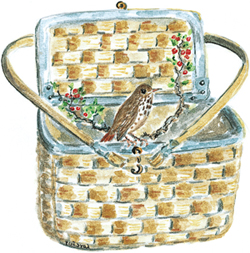
Paint big, scary eyes onto a helium-filled Mylar balloon, and tie it to a fence or tree to frighten the birds from crops and fruit. Move the balloon every few days to keep the birds guessing.
Discourage birds from feasting on raspberries, currants, and gooseberries by entwining the bushes in thick, black thread.
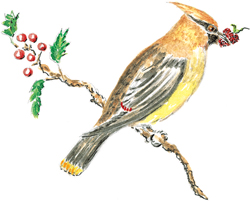
Victorians tied up their currant and gooseberry bushes with rope. Bunch up the gooseberry branches with twine or strips of cotton (or the legs of panty hose) so it resembles a tightly gathered bouquet tied in three places, and the berries will be hidden in the foliage. This works best for young bushes.
Researchers at Cornell University found they could reduce fruit crop damage from birds by 50 percent by spraying plants with a solution of sugar water. Dissolve 11 (yes, 11!) pounds of sugar in 1 gallon warm water and spray the bushes.
To deter crows from sampling corn seedlings: pound stakes randomly around your corn patch, then thread string between posts and across the patch. The string will look like a giant spiderweb.
To stop birds from eating or pecking fruit, drape dark-colored polyester netting (you can buy cheap stuff in 6-foot widths) over fruit trees or bushes. Attach netting with clothespins.
Dissuade crows from raiding newly planted beds by laying sheets of aviary or chicken wire loosely over the ground. The slightly undulating surface confuses them.
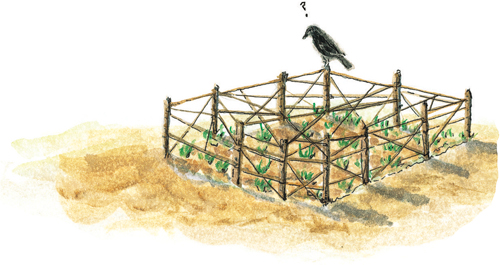
To discourage moles, sink a line of glass bottles into the soil with about 1 inch of neck exposed. The weird whistling sound of wind blowing across the bottle tops disrupts moles’ sensitive hearing and hinders their ability to find prey.
 Disturb moles’ peace by poking noisy little toy windmills into the soil throughout your yard. The vibrations will drive them away.
Disturb moles’ peace by poking noisy little toy windmills into the soil throughout your yard. The vibrations will drive them away.
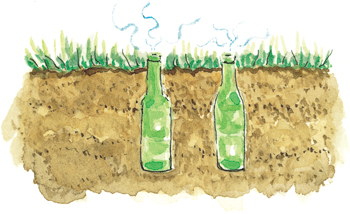
 Keep gophers in their place and out of yours by stuffing ammonia-soaked rags into their tunnels.
Keep gophers in their place and out of yours by stuffing ammonia-soaked rags into their tunnels.
 Plant living barriers of oleanders and gopher purge around areas to be protected.
Plant living barriers of oleanders and gopher purge around areas to be protected.
 Create raised beds, and line the bottoms with hardware cloth (heavy-gauge wire mesh sold in hardware stores).
Create raised beds, and line the bottoms with hardware cloth (heavy-gauge wire mesh sold in hardware stores).
 Protect special plantings with ½-inch mesh fencing 2 feet below the ground and 2 feet above.
Protect special plantings with ½-inch mesh fencing 2 feet below the ground and 2 feet above.
Try these maneuvers to keep mice away from your plants:
 Make collars out of hardware cloth or steel wool to protect tree trunks from nibbling mice (stops rabbits, too).
Make collars out of hardware cloth or steel wool to protect tree trunks from nibbling mice (stops rabbits, too).
 For small trees, cut the top and bottom off a 1-gallon plastic jug, slit the side to fit the jug around the trunk, then close it with duct tape.
For small trees, cut the top and bottom off a 1-gallon plastic jug, slit the side to fit the jug around the trunk, then close it with duct tape.
 Sprinkle garlic powder around trees, plants, and bulbs. Reapply after a rain.
Sprinkle garlic powder around trees, plants, and bulbs. Reapply after a rain.
 Spray the exterior foundation of your potting shed with white vinegar or ammonia.
Spray the exterior foundation of your potting shed with white vinegar or ammonia.
 Stuff entry holes with stainless steel or copper scouring pads (not steel wool, as it rusts), and caulk or putty over the pad.
Stuff entry holes with stainless steel or copper scouring pads (not steel wool, as it rusts), and caulk or putty over the pad.
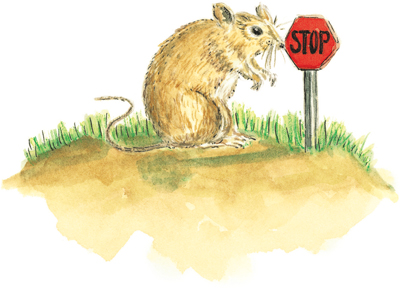
Most gardeners agree that a strong, tall fence (preferably electric), tilted at a 45-degree angle, or two fences about 5 feet apart, are the longest-lasting solutions to a deer problem. But, in case a fence isn’t in your budget, or doesn’t fit in with your garden design plans, here are some alternatives:
Protect small plants with cloches made from plastic milk jugs, bottomless bottles, screens, or floating row covers—thin sheets of material that let light penetrate but keep out bugs, birds, and animals. (They can be found at any garden center.) Prop the row cover up on chopsticks, cover the tips with grated-cheese shakers, and weigh it all down with rocks.

Use cloches to protect your plants and get an earlier harvest.
Dangle strips of Mylar from branches. The constant flickering and flashing alarm deer.
Drape rosebushes and other favorite shrubs under thin sheets of dark polyester netting (it’s nearly invisible), and secure with clothespins.
For small garden plots, or to protect some favorite bushes, spread chicken wire on the ground, and allow it to undulate. Afraid of catching their hooves in the wire, deer will avoid the area.
String fishing line around small garden plots at about 2 feet and 4 feet high. Or string the line in a weblike pattern through the bushes on the perimeter of your garden. Deer can’t see the line, and once they bump into it, they avoid the area.
Many seasoned deer battlers swear that dirty undies hung on bushes will keep deer far away. My only suggestion is, do this at night, and try to remember to remove them before your neighbors wake up.
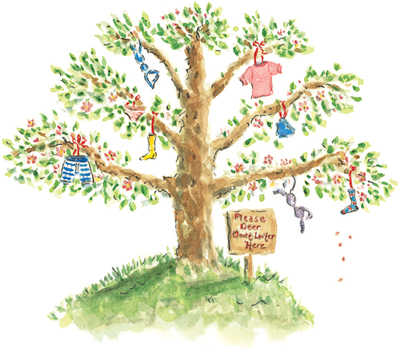
Going offensive with dirty undies.
Spread dog and human hair clippings (the dirtier the better) on and around plants, or stuff the hair into mesh bags and hang them throughout the foliage. I tried this with clean hair, and it had no effect, but after two days of not shampooing, it did the trick. While you’re at it, spread a little urine, too—human, dog, coyote, fox—all but the human kind are available via catalog.
Rotten eggs and beef bouillon are ingredients in many commercial deer repellents. Break a dozen eggs into a bucket, add 4 cubes of beef bouillon, and fill with water. Cover with a lid and let sit until the mixture stinks. Add 2 tablespoons liquid soap per gallon of water, hold your nose, and spray the plants.
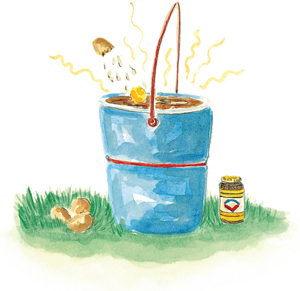
The longer rotten egg sauce sits, the stinkier it gets.
Spray plants with Coast of Maine Fermented Salmon, its odor is worse than the most fetid pair of tennis shoes. Many Maine islanders, whose gardens are seriously threatened by deer, swear that this treatment lasts up to 4 weeks. Caution: Don’t do this before an outdoor party or picnic; it will drive your guests indoors (or away).
Spray with Garlic Soup (see recipe) or try Hinder, a commercial repellent made from ammonium soaps, that can be used even on edible plants.
Here are the plants that deer usually don’t touch, but remember, when deer are hungry, ANYTHING’s fair game.
acanthus |
euphorbia |
|---|---|
agapanthus |
ferns |
ageratum |
foxglove |
aster |
geranium |
astilbe |
holly |
bachelor’s buttons |
iris |
barberry |
jasmine |
bay |
juniper |
bee-balm |
lantana |
bottlebrush |
lavatera |
boxwood |
mahonia |
buddleia |
penstemon |
calendula |
salvias |
California poppy |
scabiosa |
Canterbury bell |
tansy |
columbine |
trumpet vine |
coreopsis |
veronica |
cosmos |
violet |
crocus |
wintergreen |
day lily |
wisteria |
dicentra |
Raccoons can cause havoc in your gardens and containers. These two methods of deterrence are endorsed by The Humane Society of the United States:
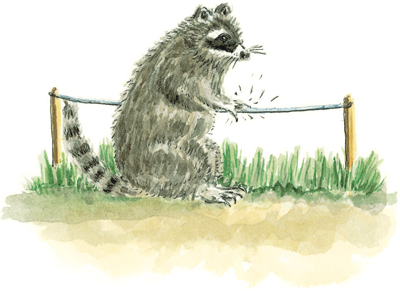
 Sprinkle garlic powder, cayenne pepper, black pepper, or Tabasco on the soil around treasured bulbs or other plants, and the raccoons will keep their distance.
Sprinkle garlic powder, cayenne pepper, black pepper, or Tabasco on the soil around treasured bulbs or other plants, and the raccoons will keep their distance.
 Run a single strand of low-voltage electric wire around the area you want to protect. The wire need be only a few inches (6, at most) off the ground. I did this around my pond, where the raccoons were raiding nightly, and they never returned. My wire is on a light sensor and comes on only at night, when raccoons are out hunting.
Run a single strand of low-voltage electric wire around the area you want to protect. The wire need be only a few inches (6, at most) off the ground. I did this around my pond, where the raccoons were raiding nightly, and they never returned. My wire is on a light sensor and comes on only at night, when raccoons are out hunting.
 Never plant potatoes in the same plot two years in a row. Beetles overwinter in the soil, and will attack potatoes when they emerge. Cover plants with a mulch of straw or kelp, or use floating row covers.
Never plant potatoes in the same plot two years in a row. Beetles overwinter in the soil, and will attack potatoes when they emerge. Cover plants with a mulch of straw or kelp, or use floating row covers.
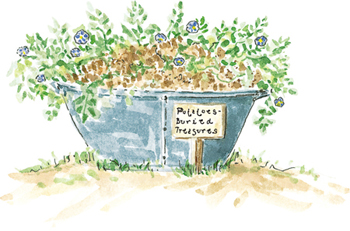
 Plant potatoes in a bottomless half-barrel or bushel basket and hill as you would in your garden. When the basket is full, surround the potatoes with repellent onion and garlic plants—a successful combo that’s been used for centuries against the potato beetle.
Plant potatoes in a bottomless half-barrel or bushel basket and hill as you would in your garden. When the basket is full, surround the potatoes with repellent onion and garlic plants—a successful combo that’s been used for centuries against the potato beetle.
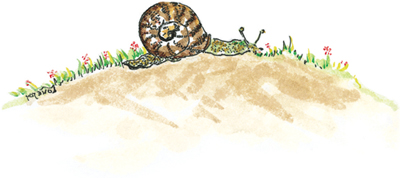
 Collect cut hair from local barber shops and sprinkle it on top of the soil. A full shoe box covers 100 square feet.
Collect cut hair from local barber shops and sprinkle it on top of the soil. A full shoe box covers 100 square feet.
 Scatter pine needles, coffee grounds, crushed eggshells, or diatomaceous earth to provide a scratchy barrier around plants you want to protect. Reapply after a rain.
Scatter pine needles, coffee grounds, crushed eggshells, or diatomaceous earth to provide a scratchy barrier around plants you want to protect. Reapply after a rain.
 Copper strips produce a shock when snails and slugs try to cross them. Purchase inexpensive, thin copper in craft stores, and wrap pots, plants, and trees with a protective band. (Many gardeners lay these strips perpendicular to the ground for good contact with the antennae.)
Copper strips produce a shock when snails and slugs try to cross them. Purchase inexpensive, thin copper in craft stores, and wrap pots, plants, and trees with a protective band. (Many gardeners lay these strips perpendicular to the ground for good contact with the antennae.)
 Use long strips of metal screen, about 5 inches wide, and bury them 3 inches down into the soil. Copper screen can do double duty: the jagged top stops invaders from crossing.
Use long strips of metal screen, about 5 inches wide, and bury them 3 inches down into the soil. Copper screen can do double duty: the jagged top stops invaders from crossing.
Soil scientist Dr. Michael Glenn and entomologist Dr. Garp Puterka developed the kaolin spray, which changes a plant’s surface and not only makes it unrecognizable and inhospitable to insects, but also increases photosynthesis and protects it from sun scald.
Stop injurious codling moths from attacking your developing apple trees and laying eggs on tree trunks with a weekly regimen of a kaolin clay mixture called Surround At Home (see Resources). Begin spraying as soon as petals drop from the blossoms. The rough, gritty powder acts as an impenetrable barrier for both egg laying and feeding. Repeat weekly for 8 weeks.
Halt cucumber beetles, codling moths, and leaf-hoppers in their tiny tracks with a barrier of Surround At Home. Check your journal or calendar (see here) and spray plants before the beetles arrive in your garden. These innocent-looking beetles and their larvae, the corn rootworm, are responsible for damage to sixty-one types of crops and innumerable garden plants.

Kaolin spray zaps codling moths and cucumber beetles.
Trichogramma wasps, which you can order from certain garden supply centers (see Resources), will attack codling moth eggs on your apple trees.
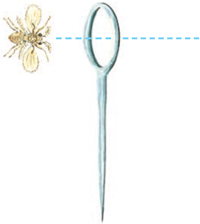
These wasps fit through the eye of a darning needle.
Cover beds of plants such as lettuce, brassicas, asparagus, and small plots of corn, which are constantly attacked by insects, with floating row covers or fine netting. If the insects can’t reach the food, they can’t do any damage. (These covers also discourage rabbits, mice, and deer.)
 Lay down small branches of spiny holly leaves as a barrier around plants to protect them from rabbits and other ground-feeding critters.
Lay down small branches of spiny holly leaves as a barrier around plants to protect them from rabbits and other ground-feeding critters.
 Encircle plants being eaten by rabbits (or snails) with the large, dried, prickly seed vessels of the liquidambar (sweet gum) tree. Gather the pods in the fall, and store in a dry area. In early spring, place them firmly in the soil surrounding the plants.
Encircle plants being eaten by rabbits (or snails) with the large, dried, prickly seed vessels of the liquidambar (sweet gum) tree. Gather the pods in the fall, and store in a dry area. In early spring, place them firmly in the soil surrounding the plants.
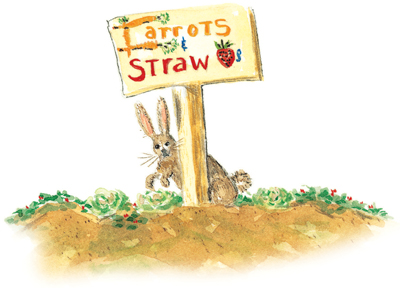
 Shake baby powder on young seedlings.
Shake baby powder on young seedlings.
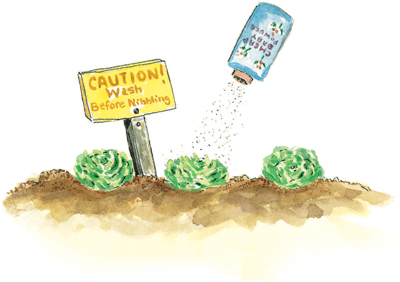
 Sprinkle garlic powder on plants.
Sprinkle garlic powder on plants.
 Many organic gardeners surround prized bushes with a thick planting of garlic and wormwood, which they claim offends rabbits’ discriminating sense of smell.
Many organic gardeners surround prized bushes with a thick planting of garlic and wormwood, which they claim offends rabbits’ discriminating sense of smell.
 Whenever you cut your hair, or your dog’s hair, scatter it along the edges of your garden beds, and woodchucks will veer off course.
Whenever you cut your hair, or your dog’s hair, scatter it along the edges of your garden beds, and woodchucks will veer off course.
 To thwart an invasion of woodchucks, drizzle pure vanilla extract (no cheap stuff for these connoisseurs) onto nice lettuce in a Havahart trap. The furry garden pirates can’t withstand the temptation.
To thwart an invasion of woodchucks, drizzle pure vanilla extract (no cheap stuff for these connoisseurs) onto nice lettuce in a Havahart trap. The furry garden pirates can’t withstand the temptation.
 Install a short, L-shaped, chicken-wire fence around beds plagued by hungry woodchucks. The leg of the “L” should trail along the ground about 1 foot (facing away from the garden).
Install a short, L-shaped, chicken-wire fence around beds plagued by hungry woodchucks. The leg of the “L” should trail along the ground about 1 foot (facing away from the garden).
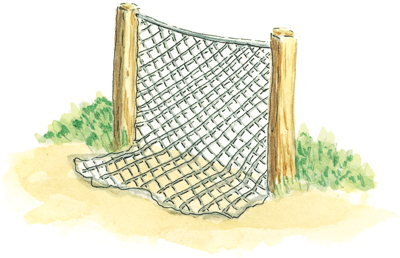
Plant pathologists in Mississippi found that if you spread aluminum foil on the soil around tomatoes, peppers, and squash, you can prevent viruses transmitted by thrips and aphids. Basil also flourishes with this protection and the extra warmth and light.
 Tape aluminum foil to the fences or walls behind tomatoes and peppers to increase light and heat and to discourage and confuse insects.
Tape aluminum foil to the fences or walls behind tomatoes and peppers to increase light and heat and to discourage and confuse insects.
 To deter cutworms and stop tomato blight, wrap tomato stems in a sleeve of aluminum foil (buried at least 1 inch into the soil). Use the same technique with squash and cucumber vines to halt borers in their tracks.
To deter cutworms and stop tomato blight, wrap tomato stems in a sleeve of aluminum foil (buried at least 1 inch into the soil). Use the same technique with squash and cucumber vines to halt borers in their tracks.
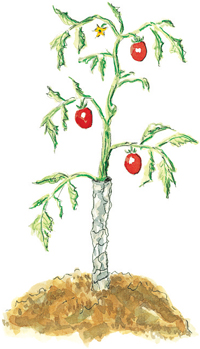
Protect plants that are often attacked by pests with an antifeedant spray composed of fragrant essential oils. Available in health-food stores and herb shops, oils of peppermint, corn or Japanese mint, and pennyroyal have antimicrobial, insecticidal, and repellent properties.
Mix ⅛ teaspoon (10 drops) essential oil and ⅛ teaspoon liquid soap in 1 quart water. Spray on the foliage of beleaguered plants. Use caution when mixing; pure essential oils are highly concentrated extracts composed mostly of volatile fatty acids, and may irritate the skin.